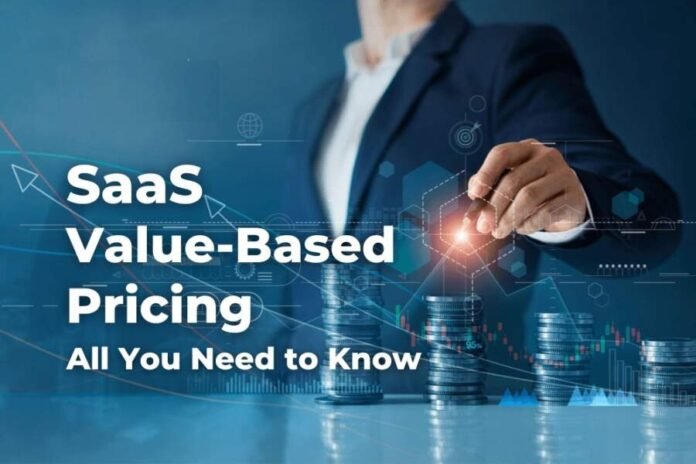Choosing the correct pricing method for your B2B SaaS business can be challenging.
However, having the right pricing strategy can set you apart from the crowded B2B SaaS world and set you up for success.
According to a Demand Gen B2B buyers survey report, 82% of respondents say pricing is their top variable when evaluating solution providers:

There are multiple pricing models in the B2B SaaS business, but in our experience, the value-based pricing method is the best option for B2B SaaS and subscription businesses.
According to pricing insights from 2,200 SaaS companies, 39% of companies have adopted value-based pricing:

In this article, we’ll discuss what value-based pricing strategy is, how to implement it as well as its benefits and limitations.
Let’s get started.
What is SaaS Value-based Pricing?
Value-based pricing is a dynamic pricing model where product prices are informed by the value of the product as well as customers’ willingness to pay.
In this case, when calculating how much to price your product, you don’t look at the historical prices, your intended profit margins as well as your production and overhead costs.
Instead, your pricing is informed by how much your potential customers are willing to pay. Thus, you must do thorough market research to understand your target customers.
As explained in this Attrock article if you don’t get your pricing right then all your B2B SaaS lead generation strategies and efforts will go to waste so you need to designed a appropriate pricing strategy for your product and services.
A good example of a B2B SaaS platform that uses value-based pricing is Drift. It structures its plans based on users:

Why Value-Based Pricing is the Best Option for Your B2B SaaS?
Gartner’s predictions show that the global B2B SaaS spending is at $145 billion.

As you can see, companies are spending more than ever on SaaS products. You need to get your pricing right to stand out from the competition and grow your business.
Here are the reasons you should choose value-based pricing over other pricing methods:
1. Helps Reduce Customer Churn
The business world is slowly becoming customer-focused. To offer a better customer experience and streamline recurring billing and payment collection processes, SaaS companies have opted to use subscription management software.
This helps to retain customers.
When you price your products based on their perceived value, you can also reduce customer churn significantly. This is because you can set price plans that meet their specific needs.
2. Improves Customer Support
The value-based pricing method is customer-centric.
Before implementing this pricing model, you must do thorough research by collecting data through surveys, customer feedback, and interviews.
When you give this attention to your target customers, you strengthen your relationships. And because you have enough information about your customers, you can offer better support and meet their needs.
3. Improves Product Optimization
With value-based pricing, your pricing is aligned with customers’ needs and willingness to pay.
Having conducted thorough customer research, you can be able to customize your product pricing based on your customers’ needs and spending power.
For example, you can optimize your HCP enegeement platform as per user requirements and also you can design multiple pricing models for your an as per the use and user category. It help you to increase the users base and revenue.
Limitations of Value-Based Pricing
Even though value-based pricing is a great option for B2B SaaS startups, it isn’t flawless. Here are a few reasons this pricing strategy might not be a suitable option for you.
1. You Need More Time and Resources to Adopt Value-Based Pricing
To implement this pricing strategy, you need to quantify your buyer personas which can be time-consuming and resource-intensive.
Besides, since customers’ needs keep on evolving, you must do continual customer research. Unless you’re prepared, this strategy might not work for you.
2. It’s Not 100% Reliable
It’s safe to say that value-based pricing is an approximation of the right positioning, pricing, and packaging for your product. You can’t get it right at all times.
Besides, since value keeps on changing, you cannot be sure that your product will retain the same value for a long period.
How to Implement Value-Based Pricing
A value-based pricing strategy is a great option for B2B SaaS success. However, you need to know how to adopt it. Here are three steps to guide you:
1. Conduct a Thorough Customer Analysis
To be successful with value-based pricing, you need to find out what your customers are willing to pay. Your pricing strategy must be backed up by solid data and not guesswork.
You can do customer analysis in multiple ways. For instance, you can run surveys, cold call your prospective customers, etc.
2. Conduct a Total Market Analysis
Next, you need to dig deeper into your total target market. This will help you understand your prospective customers or new markets that you want to target.
You can run surveys, interview potential customers, or use other market research techniques.
According to a HubSpot survey, survey 76% of small businesses use surveys whereas 56% use interviews for market research:

3. Conduct a Competitor Analysis
Lastly, research your competitors.
Head over to Google, LinkedIn, G2, and other platforms to find out how your competitors are pricing their products.
Once you have all this information, setting up your pricing strategy becomes easier.
Conclusion
To stand out in today’s value-driven market, you need to price your products based on their perceived value and what customers are willing to pay.
Value-based pricing helps you to be customer-centric in all your business operations thus it’s the best pricing strategy for B2B SaaS startups.
Read Also: What Is The IVR Software And Can You Benefit From It?






























































